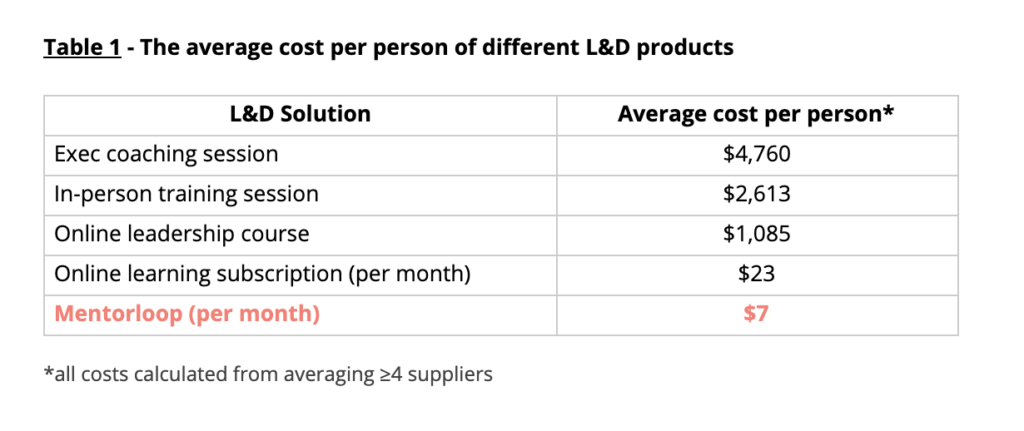Need help convincing your leadership team that mentoring programs are a great investment? We got you covered.
While execs may have the business’s bottom line—and little else—in their sights, it’s important to remind them that there are more than a few short-term or immediate actions they can take to get them where they ultimately want to go. That’s because there are just as many—if not more—perks to long-term developmental initiatives as there are to short-term financial ones.
Future-proofing a business doesn’t just have to do with dollars and cents, but with people: learning how to best train and onboard them, promote knowledge sharing and diversity, increase productivity and engagement, reduce turnover, and more.
How to Pitch a Mentoring Program to Leadership
1. Align Your Program with Organisational Goals
Your organisation likely has goals around retention, learning and development, and/or diversity and inclusion. Find out what these goals are and align your program with them.
Retention
For example, if your company is focused on retention: Did you know that retention rates are much higher for mentees (72%) and mentors (69%) than for employees who don’t participate in the mentoring program (49%)?
Learning & Development
If they’re interested in learning and development: Did you know that mentors report gaining more leadership identity and skills, and that employees in mentoring programs are 5x more likely to advance in pay grade?
Diversity & Inclusion
Or, if they have goals around diversity and inclusion: Did you know that mentoring programs boost minority representation at the management level by 9%-24% and improve promotion and retention rates for minorities and women by 15%-38%?
We’ve put together this handy tip sheet you can share with leadership.
Here’s Nikki Scheuder from Arup sharing how they aligned their mentoring program goals with Arup’s overall company goals and values:
2. Show Leadership How This Would Impact Their Teams
Mentoring programs aren’t just great in theory, there are some real, tangible benefits they provide:
- Passing down knowledge of operations can not only benefit your own department, but others as well.
- Having more women and POC in leadership has historically been great for businesses in general.
- Leveraging a mentoring program during onboarding can guide new hires, get them more comfortable quicker, help them navigate company culture, and reduce your new-hire turnover rate.
3. Set Measurable Goals and Show Them How They Can Be Achieved
Whenever a new project—like a mentoring program—is proposed, there’s always a bit of apprehension, which is understandable. But if you show a tangible path to success, you ease the anxiety, doubt, and apprehension about the investment of both time and money.
Help your leadership team connect the dots by showing them helpful case studies that outline the real-world application and success of mentoring programs in similar companies.
4. Provide Plans for the Future
To get leadership buy-in it’s important to show that a mentoring program is sustainable and not a one-time thing, because investing in one-off projects isn’t attractive to people with their eye on the bottom line.
If you’re doing a program pilot, show leadership a plan for scaling or expansion to different departments. Also demonstrate how the benefits of this program would not be limited to one department, cohort, or team. Show them how it will in fact foster a culture of interdepartmental unification and collaboration.
5. Demonstrate How Cost-Effective Mentoring Can Be
Bring your pitch back to HR or L&D goals: How much of the entire HR budget has been earmarked to reach them (vs other functions such as admin and recruitment)? How much more cost-effective will mentoring be as a compliment to other L&D initiatives?
A fun fact you can share: a Mentoring Program with Mentorloop is 680X cheaper than executive coaching and 373X cheaper than an in-person training session. Or, just show them this chart:

The Takeaway
Ready to launch your mentoring program and just need to secure that leadership buy-in? You’ll have better chances of success getting leadership onboard by following these suggestions. And if you need any additional help, don’t hesitate to reach out to us!
Here are more tips from Arup mentoring program coordinator, Nikki Scheuder, on getting your mentoring program approved by leadership:
Interested in learning more about the Arup mentoring program? Read the case study or watch our chat with their program coordinators Nikki and Jacqueline:
Start building a culture of mentoring at your organisation, with Mentorloop; download the toolkit to get started.




